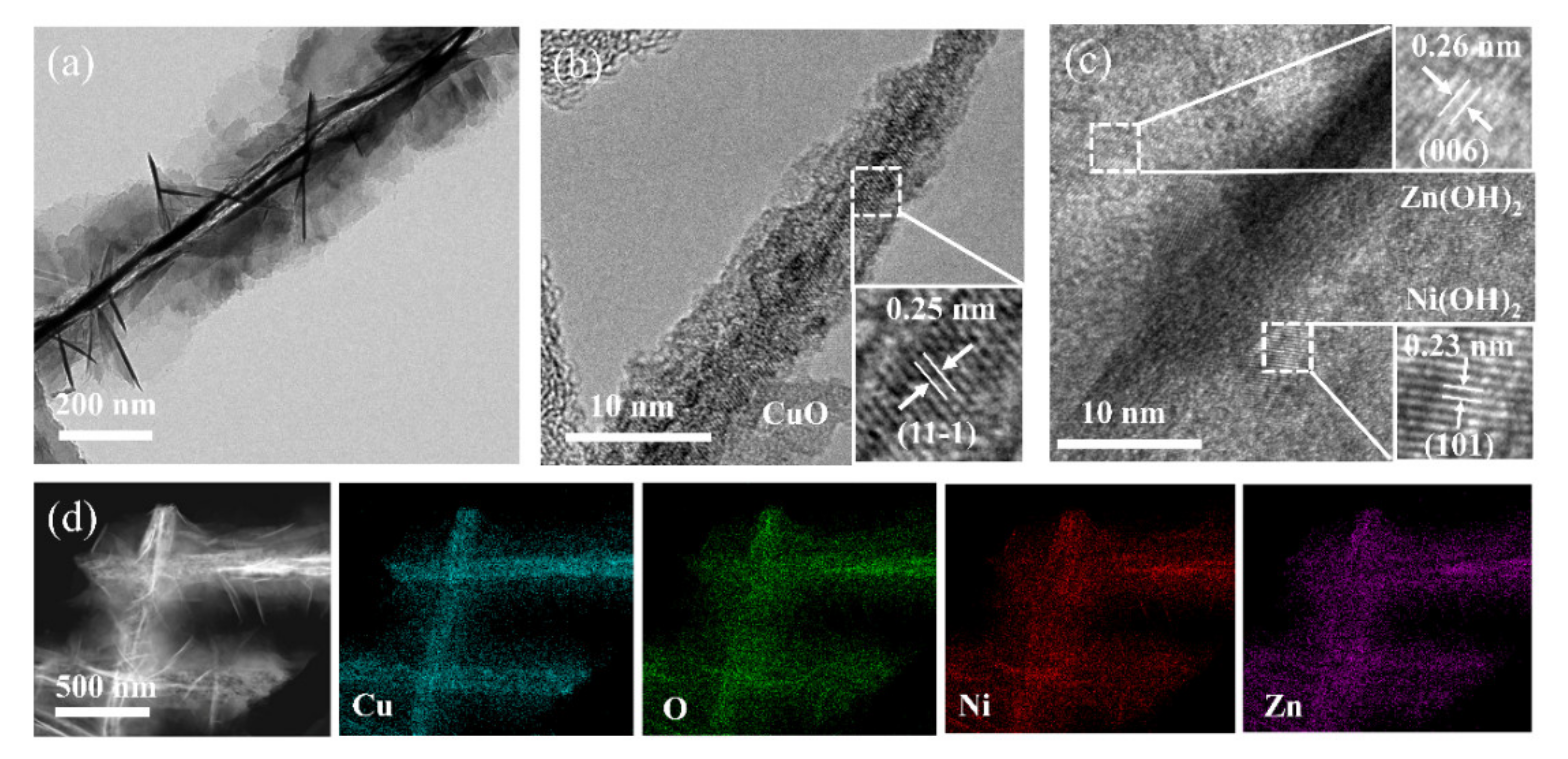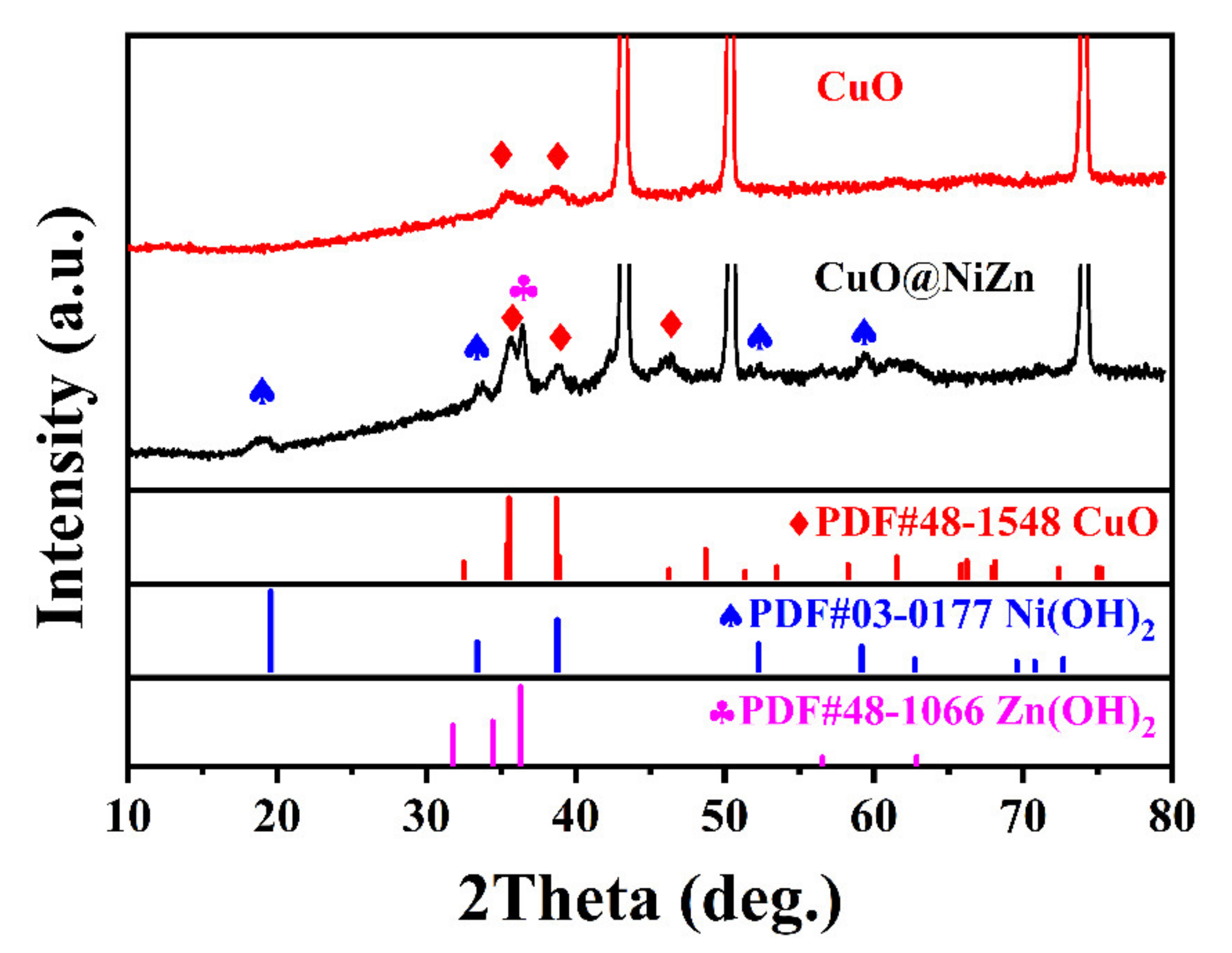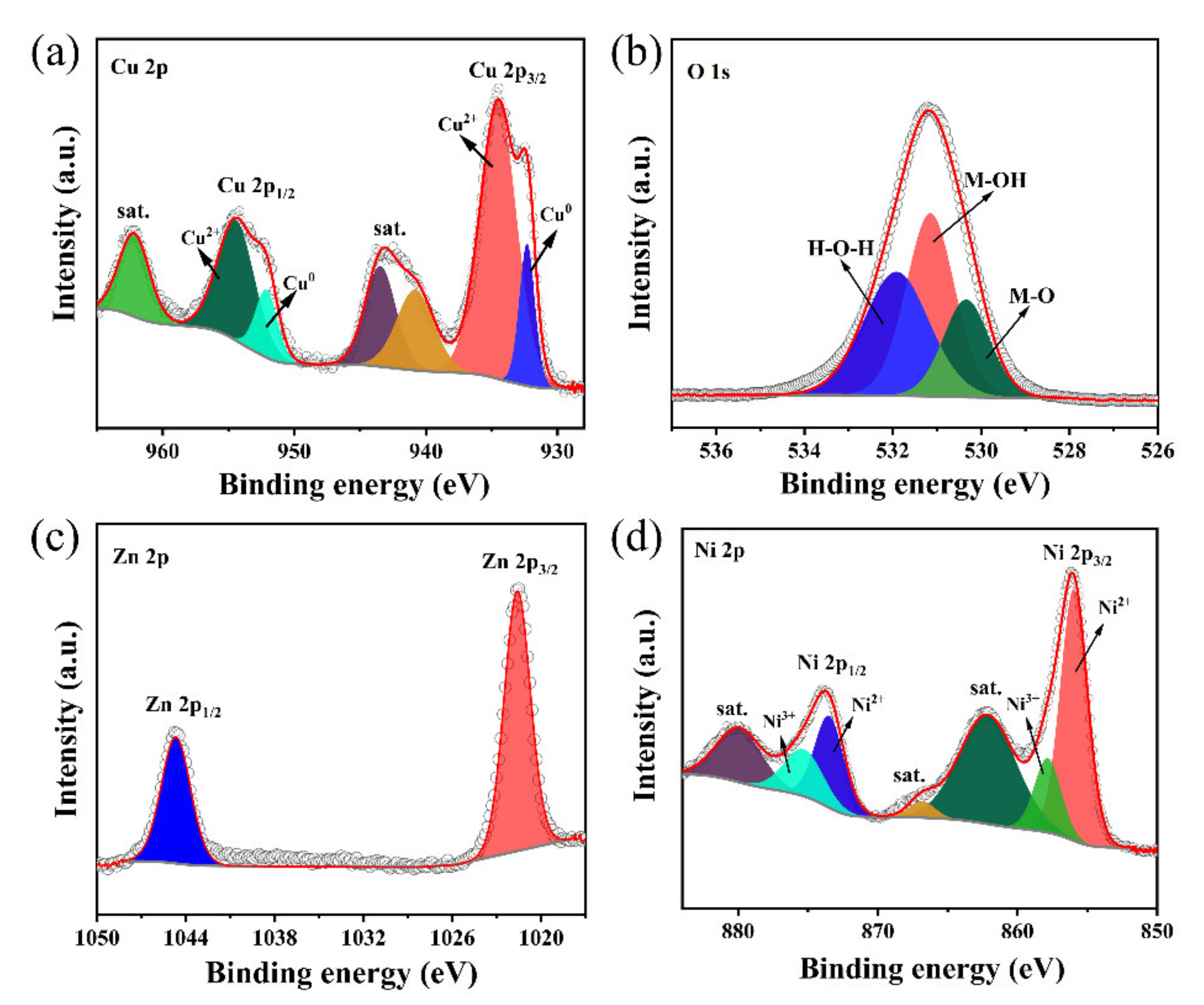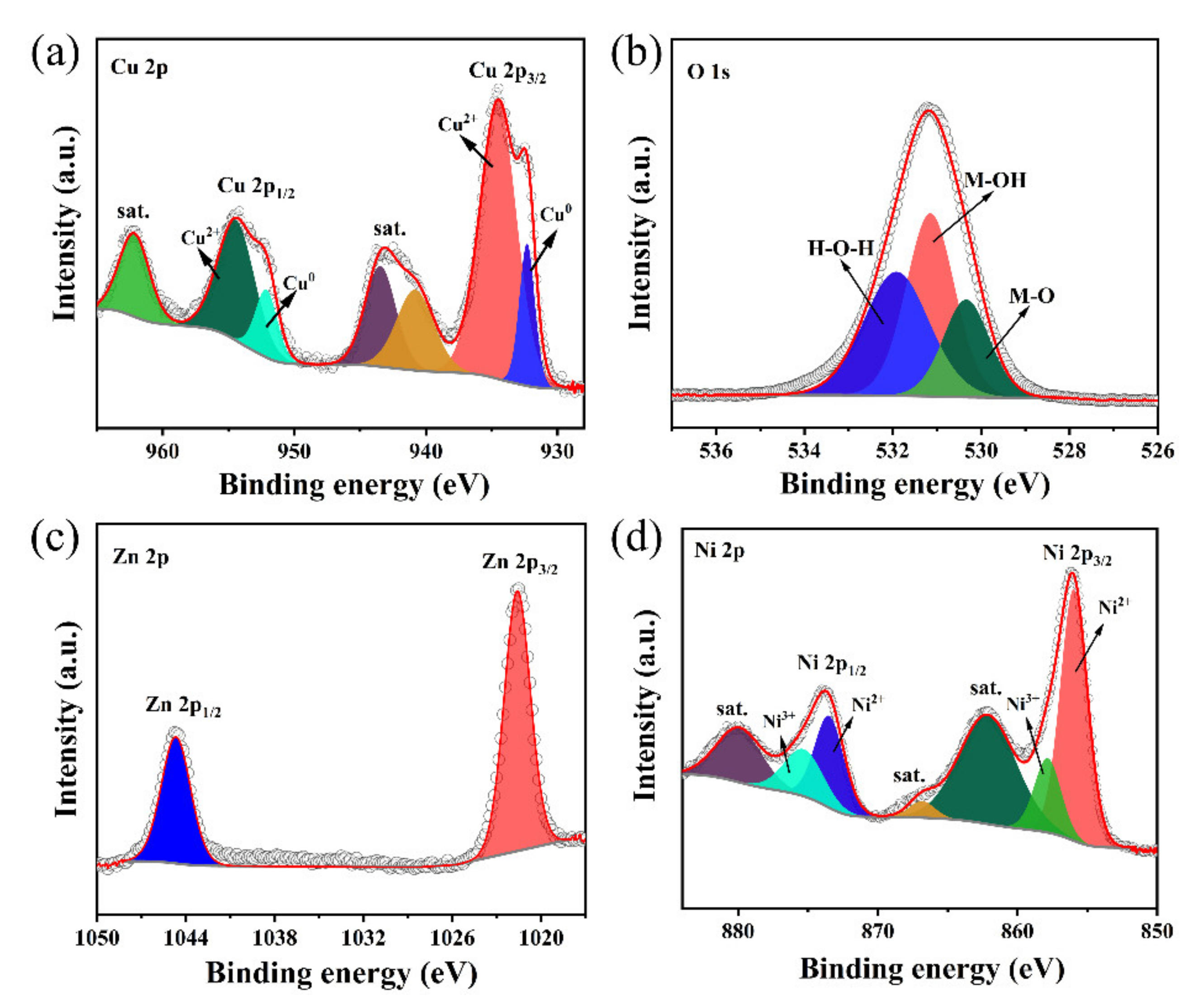Self-Supported Sheets-on-Wire CuO@Ni(OH)2/Zn(OH)2 Nanoarrays for High-Performance Flexible Quasi-Solid-State Supercapacitor
Abstract
1. Introduction
2. Results
3. Conclusions
Supplementary Materials
Author Contributions
Funding
Institutional Review Board Statement
Informed Consent Statement
Data Availability Statement
Conflicts of Interest
References
- Tarascon, J.M.; Armand, M. Issues and challenges facing rechargeable lithium batteries. Nature 2001, 414, 359–367. [Google Scholar] [CrossRef]
- Aric, A.S.; Bruce, P.; Scrosati, B.; Tarascon, J.M.; Schalkwijk, W.V. Nanostructured materials for advanced energy conversion and storage devices. Nat. Mater. 2005, 4, 366–377. [Google Scholar] [CrossRef]
- Yoo, H.D.; Markevich, E.; Salitra, G.; Sharon, D.; Aurbach, D. On the challenge of developing advanced technologies for electrochemical energy storage and conversion. Mater. Today 2014, 17, 110–121. [Google Scholar] [CrossRef]
- Li, M.; Jun, L.; Zhongwei, C.; Khalil, A. 30 years of lithium-ion batteries. Adv. Mater. 2018, 1800561. [Google Scholar] [CrossRef]
- Nitta, N.; Wu, F.; Lee, J.T.; Yushin, G. Li-ion battery materials: Present and future. Mater. Today 2015, 18, 252–264. [Google Scholar] [CrossRef]
- You, J.; Luo, S.; Liu, Y.; Li, G. Interface engineering of highly efficient perovskite solar cells. Science 2014, 345, 542–546. [Google Scholar]
- Simon, P.; Gogotsi, Y.; Dunn, B. Where do batteries end and supercapacitors begin? Science 2014, 343, 1210–1211. [Google Scholar] [CrossRef] [PubMed]
- Simon, P.; Gogotsi, Y. Materials for electrochemical capacitors. Nat. Mater. 2008, 7, 845–854. [Google Scholar] [CrossRef] [PubMed]
- Yu, Z.; Tetard, L.; Lei, Z.; Thomas, J. Supercapacitor electrode materials: Nanostructures from 0 to 3 dimensions. Energy Environ. Sci. 2015, 8, 702–730. [Google Scholar] [CrossRef]
- Miller, J.R.; Burke, A.F. Electrochemical capacitors: Challenges and opportunities for real-world applications. Electrochem. Soc. Interface 2008, 17, 53–57. [Google Scholar] [CrossRef]
- Brousse, T.; Bélanger, D.; Long, J.W. To be or not to be pseudocapacitive? J. Electrochem. Soc. 2015, 162, 5185–5189. [Google Scholar] [CrossRef]
- Arbizzani, C.; Yu, Y.; Li, J.; Xiao, J.; Xia, Y.Y.; Yang, Y.; Santato, C.; Raccichini, R.; Passerini, S. Good practice guide for papers on supercapacitors and related hybrid capacitors for the Journal of Power Sources. J. Power Sources 2020, 450, 227636. [Google Scholar] [CrossRef]
- Zhang, L.L.; Zhao, X.S. Carbon-based materials as supercapacitor electrodes. Chem. Soc. Rev. 2009, 38, 2520–2531. [Google Scholar] [CrossRef]
- Shao, Y.; El-Kady, M.F.; Wang, L.J.; Zhang, Q.; Li, Y.; Wang, H.; Mousavi, M.F.; Kaner, R.B. Graphene-based materials for flexible supercapacitors. Chem. Soc. Rev. 2015, 44, 3639–3665. [Google Scholar] [CrossRef]
- Barbieri, O.; Hahn, M.; Herzog, A.; Kotz, R. Capacitance limits of high surface area activated carbons for double layer capacitors. Carbon 2005, 43, 1303–1310. [Google Scholar] [CrossRef]
- Fleischmann, S.; Mitchell, J.B.; Wang, R.C.; Zhan, C.; Jiang, D.E.; Presser, V.; Augustyn, V. Pseudocapacitance: From fundamental understanding to high power energy storage materials. Chem. Rev. 2020, 120, 6738–6782. [Google Scholar] [CrossRef] [PubMed]
- Lu, Q.; Chen, J.G.G.; Xiao, J.Q. Nanostructured electrodes for high-performance pseudocapacitors. Angew. Chem. Int. Ed. 2013, 52, 1882–1889. [Google Scholar] [CrossRef] [PubMed]
- Lukatskaya, M.R.; Kota, S.; Lin, Z.F.; Zhao, M.Q.; Shpigel, N.; Levi, M.D.; Halim, J.; Taberna, P.L.; Barsoum, M.; Simon, P.; et al. Ultra-high-rate pseudocapacitive energy storage in two-dimensional transition metal carbides. Nat. Energy 2017, 2, 17105. [Google Scholar] [CrossRef]
- Brisse, A.-L.; Stevens, P.; Toussaint, G.; Crosnier, O.; Brousse, T. Ni(OH)2 and NiO based composites: Battery type electrode materials for hybrid supercapacitor devices. Materials 2018, 11, 1178. [Google Scholar] [CrossRef] [PubMed]
- Augustyn, V.; Simon, P.; Dunn, B. Pseudocapacitive oxide materials for high-rate electrochemical energy storage. Energy Environ. Sci. 2014, 7, 1597–1614. [Google Scholar] [CrossRef]
- He, D.; Wang, G.D.; Liu, G.L.; Bai, J.H.; Suo, H.; Zhao, C. Facile route to achieve mesoporous Cu(OH)2 nanorods on copper foam for high-performance supercapacitor electrode. J. Alloys Compd. 2017, 699, 706–712. [Google Scholar] [CrossRef]
- Liu, Y.; Cao, X.Y.; Jiang, D.G.; Jia, D.D.; Liu, J.Q. Hierarchical CuO nanorod arrays in situ generated on three-dimensional copper foam via cyclic voltammetry oxidation for high-performance supercapacitors. J. Mater. Chem. A 2018, 6, 10474–10483. [Google Scholar] [CrossRef]
- Liu, X.X.; He, Q.; Wang, Y.; Wang, J.; Chen, J.S. MOF-reinforced Co9S8 self-supported nanowire arrays for highly durable and flexible supercapacitor. Electrochim. Acta 2020, 346, 136201. [Google Scholar] [CrossRef]
- He, Q.; Liu, X.X.; Wu, R.; Chen, J.S. PVP-Assisted Synthesis of Self-Supported Ni2P@Carbon for High-Performance Supercapacitor. Research 2019, 2019, 8013285. [Google Scholar] [CrossRef]
- Liu, X.X.; Wu, R.; Wang, Y.; Xiao, S.H.; He, Q.; Niu, X.B.; Blackwood, D.J.; Chen, J.S. Self-supported core/shell Co3O4@Ni3S2 nanowires for high-performance supercapacitors. Electrochim. Acta 2019, 311, 221–229. [Google Scholar] [CrossRef]
- He, Q.; Wang, Y.; Liu, X.X.; Blackwood, D.J.; Chen, J.S. One-pot synthesis of self-supported hierarchical urchin-like Ni3S2 with ultrahigh areal pseudocapacitance. J. Mater. Chem. A 2018, 6, 22115–22122. [Google Scholar] [CrossRef]
- Zhang, D.; Shao, Y.; Kong, X.; Jiang, M.; Lei, D.; Lei, X. Facile fabrication of large-area hybrid Ni-Co hydroxide/Cu(OH)2/copper foam composites. Electrochim. Acta 2016, 218, 294–302. [Google Scholar] [CrossRef]
- Zhang, A.T.; Zheng, W.; Yuan, Z.; Tian, J.M.; Yue, L.J.; Zheng, R.K.; Wei, D.; Liu, J.Q. Hierarchical NiMn-layered double hydroxides@CuO core-shell heterostructure in-situ generated on Cu(OH)2 nanorod arrays for high performance supercapacitors. Chem. Eng. J. 2020, 380, 122486. [Google Scholar] [CrossRef]
- Chen, F.; Chen, C.; Hu, Q.; Xiang, B.; Song, T.T.; Zou, X.F.; Li, W.N.; Xiong, B.X.; Deng, M.S. Synthesis of CuO@CoNi LDH on Cu foam for high-performance supercapacitors. Chem. Eng. J. 2020, 401, 126145. [Google Scholar] [CrossRef]
- Tang, Y.; Dong, L.; Wu, H.B.; Yu, X.-Y. Tungstate-modulated Ni/Ni(OH)2 interface for efficient hydrogen evolution reaction in neutral media. J. Mater. Chem. A 2021, 9, 1456–1462. [Google Scholar] [CrossRef]
- Zheng, J.; Zhang, R.; Wang, X.; Yu, P. Hydrothermally synthesized Ni(OH)2@Zn(OH)2 composite with enhanced electrochemical performance for supercapacitors. Res. Chem. Intermed. 2018, 44, 6637–6648. [Google Scholar] [CrossRef]
- Li, Z.; Shao, M.; Zhou, L.; Zhang, R.; Zhang, C.; Han, J.; Wein, M.; Evans, D.G.; Duan, X. A flexible all-solid-state micro-supercapacitor based on hierarchical CuO@layered double hydroxide core–shell nanoarrays. Nano Energy 2016, 20, 294–304. [Google Scholar] [CrossRef]
- Gao, X.R.; Liu, X.M.; Wu, D.J.; Qian, B.; Kou, Z.K.; Pan, Z.H.; Pang, Y.J.; Miao, L.Q.; Wang, J. Significant role of Al in ternary layered double hydroxides for enhancing electrochemical performance of flexible asymmetric supercapacitor. Adv. Funct. Mater. 2019, 29, 1903879. [Google Scholar] [CrossRef]
- Castle, J.E. Use of “Shake-up” Satellites in photoelectron spectra for analysis of oxide layers on metals. Nat. Phys. Sci. 1971, 234, 93–95. [Google Scholar] [CrossRef]
- Chen, J.S.; Gui, Y.; Blackwood, D.J. Self-supported phase-pure Ni3S2 sheet-on-rod nanoarrays with enhanced pseudocapacitive properties and high energy density. J. Power Sources 2016, 325, 575–583. [Google Scholar] [CrossRef]
- Chen, J.S.; Guan, C.; Gui, Y.; Blackwood, D.J. Rational design of self-supported Ni3S2 nanosheets array for advanced asymmetric supercapacitor with a superior energy density. ACS Appl. Mater. Interfaces 2017, 9, 496–504. [Google Scholar] [CrossRef]
- Yuan, C.Z.; Li, J.Y.; Hou, L.R.; Zhang, X.G.; Shen, L.F.; Lou, X.W. Ultrathin mesoporous NiCo2O4 nanosheets supported on Ni foam as advanced electrodes for supercapacitors. Adv. Funct. Mater. 2012, 22, 4592–4597. [Google Scholar] [CrossRef]
- Nguyen, T.T.; Balamurugan, J.; Kim, N.H.; Lee, J.H. Hierarchical 3D Zn-Ni-P nanosheet arrays as an advanced electrode for high-performance all-solid-state asymmetric supercapacitors. J. Mater. Chem. A 2018, 6, 8669–8681. [Google Scholar] [CrossRef]
- Bai, J.; Li, X.G.; Liu, G.Z.; Qian, Y.T.; Xiong, S.L. Unusual formation of ZnCo2O4 3D hierarchical twin microspheres as a high-rate and ultralong-life lithium-ion battery anode material. Adv. Funct. Mater. 2014, 24, 3012–3020. [Google Scholar] [CrossRef]
- Daiyan, R.; Lu, X.Y.; Tan, X.; Zhu, X.F.; Chen, R.; Smith, S.C.; Amal, R. Antipoisoning nickel-carbon electrocatalyst for practical electrochemical CO2 reduction to CO. ACS Appl. Energy Mater. 2019, 2, 8002–8009. [Google Scholar] [CrossRef]
- Huang, C.; Hu, Y.; Jiang, S.; Chen, H.C. Amorphous nickel-based hydroxides with different cation substitutions for advanced hybrid supercapacitors. Electrochim. Acta 2019, 325, 134936. [Google Scholar] [CrossRef]
- Park, S.K.; Kim, J.K.; Kang, Y.C. Excellent sodium-ion storage performances of CoSe2 nanoparticles embedded within N-doped porous graphitic carbon nanocube/carbon nanotube composite. Chem. Eng. J. 2017, 328, 546–555. [Google Scholar] [CrossRef]
- Yin, H.; Qu, H.Q.; Liu, Z.T.; Jiang, R.Z.; Li, C.; Zhu, M.Q. Long cycle life and high rate capability of three dimensional CoSe2 grain-attached carbon nanofibers for flexible sodium-ion batteries. Nano Energy 2019, 58, 715–723. [Google Scholar] [CrossRef]
- Liu, Y.; Cao, X.; Cui, L.; Zhong, Y.; Zheng, R.; Wei, D.; Barrow, C.; Razal, J.M.; Yang, W.; Liu, J. Zn-Ni-Co trimetallic carbonate hydroxide nanothorns branched on Cu(OH)2 nanorods array based on Cu foam for high-performance asymmetric supercapacitors. J. Power Sources 2019, 437, 226897. [Google Scholar] [CrossRef]
- Chen, H.C.; Qin, Y.L.; Cao, H.J.; Song, X.X.; Huang, C.H.; Feng, H.B.; Zhao, X.S. Synthesis of amorphous nickel-cobalt-manganese hydroxides for supercapacitor-battery hybrid energy storage system. Energy Storage Mater. 2019, 17, 194–203. [Google Scholar] [CrossRef]
- Gao, J.H.; Xuan, H.C.; Xu, Y.K.; Liang, T.; Han, X.K.; Yang, J.; Han, P.D.; Wang, D.H.; Du, Y.W. Interconnected network of zinc-cobalt layered double hydroxide stick onto rGO/nickel foam for high performance asymmetric supercapacitors. Electrochim. Acta 2018, 286, 92–102. [Google Scholar] [CrossRef]
- Zhang, Q.; Liu, Z.; Zhao, B.; Cheng, Y.; Zhang, L.; Wu, H.-H.; Wang, M.-S.; Dai, S.; Zhang, K.; Ding, D.; et al. Design and understanding of dendritic mixed-metal hydroxide nanosheets@N-doped carbon nanotube array electrode for high-performance asymmetric supercapacitors. Energy Storage Mater. 2019, 16, 632–645. [Google Scholar] [CrossRef]






Publisher’s Note: MDPI stays neutral with regard to jurisdictional claims in published maps and institutional affiliations. |
© 2021 by the authors. Licensee MDPI, Basel, Switzerland. This article is an open access article distributed under the terms and conditions of the Creative Commons Attribution (CC BY) license (https://creativecommons.org/licenses/by/4.0/).
Share and Cite
Jiang, J.; Liu, X.X.; Han, J.; Hu, K.; Chen, J.S. Self-Supported Sheets-on-Wire CuO@Ni(OH)2/Zn(OH)2 Nanoarrays for High-Performance Flexible Quasi-Solid-State Supercapacitor. Processes 2021, 9, 680. https://doi.org/10.3390/pr9040680
Jiang J, Liu XX, Han J, Hu K, Chen JS. Self-Supported Sheets-on-Wire CuO@Ni(OH)2/Zn(OH)2 Nanoarrays for High-Performance Flexible Quasi-Solid-State Supercapacitor. Processes. 2021; 9(4):680. https://doi.org/10.3390/pr9040680
Chicago/Turabian StyleJiang, Jianyang, Xiong Xiong Liu, Jiayu Han, Ke Hu, and Jun Song Chen. 2021. "Self-Supported Sheets-on-Wire CuO@Ni(OH)2/Zn(OH)2 Nanoarrays for High-Performance Flexible Quasi-Solid-State Supercapacitor" Processes 9, no. 4: 680. https://doi.org/10.3390/pr9040680
APA StyleJiang, J., Liu, X. X., Han, J., Hu, K., & Chen, J. S. (2021). Self-Supported Sheets-on-Wire CuO@Ni(OH)2/Zn(OH)2 Nanoarrays for High-Performance Flexible Quasi-Solid-State Supercapacitor. Processes, 9(4), 680. https://doi.org/10.3390/pr9040680






